Kahuku Medical Center’s (KMC) partnership with The Queen’s Medical Center (QMC) on its Telestroke Program is saving lives and preventing chronic disability. To date, three North Shore residents have been treated via the Telestroke Program, which went live in the fall of 2017. KMC is one of eight hospitals participating in Hawaii’s telemedicine network.
One in five Hawaii residents will have a stroke during his or her lifetime. Stroke is the third leading cause of death in Hawaii and the number one cause of chronic adult disability. Of people under age 65, only 20 percent can return to full-time work after a stroke and 80 percent are permanently disabled.
Dr. Matthew Koenig, a neurointensivist and the medical director of Telemedicine for The Queen’s Health Systems, points out that the Hawaii Islands Regional Stroke Network was created to help residents in rural areas who would otherwise need to drive an hour or more for treatment by a specialist.
“Stroke expertise is available at Kahuku Medical Center through the telemedicine program. There is no need to delay treatment because of the mistaken impression that only the larger hospitals have this expertise. At the first sign of a stroke, call 911 and you will be taken to Kahuku Medical Center’s ER,” Dr. Koenig said.
“Getting treatment as quickly as possible is absolutely vital for stroke patients. People can lose up to two million brain cells a minute if not treated, which can lead to lifelong disability or death,” explains Dr. Jason Hughes, chief medical officer at KMC.
Ambulance paramedics, trained to recognize stroke symptoms, contact the ER to let them know of the possible stroke victim, allowing the ER to set up the CAT scan and video conferencing program so the patient can immediately be examined by the neurologist at QMC and the KMC ER physician simultaneously. The CAT scan is used to determine whether the stroke is caused by bleeding in the brain or a blood clot, which can be broken up by the appropriate medicine delivered in a timely manner. The two physicians then triage the patient, determining where further care can be delivered. Two of KMC’s patients received the clot buster medication and have been discharged.
Both doctors agree that the program doesn’t work if people don’t recognize stroke symptoms. The suggested memory meme is: Act FAST. F (face, is the smile crooked?) A (arm, does one arm fall when both arms are held up?) S (speech, is it slurred or nonsensical?) and T (time, call 911 asap).



